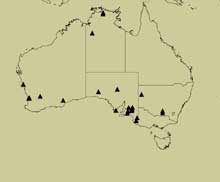Synonyms
Pharellus popei Slipinski and Tomaszewska, 2005: 371.
Diagnosis
This species is superficially similar to Paraphellus rostratus and these species can be confused easily, due to their same body shape, size and shortly rostrate heads. The obvious differences in their antennal club (1-segmented in Paraphellus vs. 3-segmented in Pharellus) serve as the best character to separate the genera.
Description
Length 1.0-1.2 mm. Winged; form oval, convex; surfaces distinctly setose with setae short, erect and pointing backwards. Brown to dark brown, ventral side opaque, dark brown, labrum and appendages brown. Dorsal surfaces between punctures with microsculpture, shiny. Head flat, regularly punctate and covered with short setae; punctures 2-3 diameters apart, each puncture smaller than an eye facet and bearing a short seta. Clypeus distinctly prominent forming short rostrum, weakly arcuate anteriorly. Eyes small, coarsely facetted, dorsally separated by about 4 times width of an eye. Antenna 10-segmented with long 3-segmented club. Pronotum widest just before base and gradually narrowing anteriorly, pronotal margins narrowly explanate and entirely visible from above; anterolateral line distinct not reaching lateral margin. Disc strongly convex medially, suddenly sloping laterally, finely punctate, punctures as large as those on frons, 2-4 diameters apart with interspaces densely reticulate but shiny. Scutellum triangular, well visible, glabrous. Elytron shiny, densely punctate, punctures irregular and 2-3 times as large as those on pronotum, usually separated by 1-2 diameters, interspaces shiny and usually polished. Elytral margins narrow, entirely visible from above, edges finely crenulate. Epipleuron narrow and extending to apex. Abdomen: ventrite 5 arcuate posteriorly, usually exposing 6th ventrite apically; postcoxal line of first ventrite incomplete, almost reaching lateral margin; postcoxal disc sparsely punctate.
Male
Male genitalia: tegmen 0.5 times, median lobe 1.2 times as long as abdomen; trabes about as long as the basal piece; parameres apparently absent.
Female
Not externally different from male.
Variation
Not observed.
 Distribution and Biology
Distribution and Biology
Widely distributed in Australia. Adults have been collected in flight intercept traps and on vegetation and probably feed on scale insects. The larva is unknown. Click on map for larger version (use the bowser 'back arrow' to return to this page).
Species References
Slipinski, A, Tomaszewska, W. 2005. Revision of the Australian Coccinellidae (Coleoptera). Part 3. Tribe Sukunahikonini. Australian Journal of Entomology, 44: 369-384.
[ Top ]
